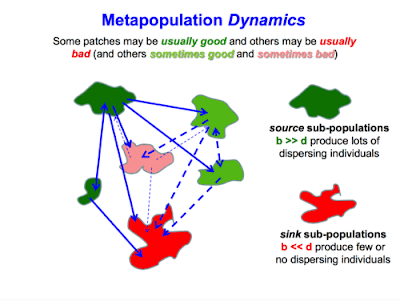Metapopulation in Ecology
 |
| Metapopulation Dynamics |
Metapopulation, in ecology, a regional group of connected populations of a species. For a given species, each metapopulation is continually being modified by increases (births and immigrations) and decreases (deaths and emigrations) of individuals, as well as by the emergence and dissolution of local populations contained within it. As local populations of a given species fluctuate in size,theybecome vulnerable to extinction
during periods when their numbers are low. Extinction of local populations is common in some species, and the regional persistence of such species is dependent on the existence of a metapopulation. Hence, elimination of much of the metapopulation structure of some species can increase the chance of regional extinction of species.
 |
| Metapopulation Structure |
The structure of metapopulations varies among species. In some species one population may be particularly stable over time and act as the source of recruits into other, less stable populations. For example, populations of the checkerspot butterfly (Euphydryas editha) in California have a metapopulation structure consisting of a number of small satellite populations that surround a large source population on which they rely for new recruits. The satellite populations are too small and fluctuate too much to maintain themselves indefinitely. Elimination of the source population from this metapopulation would probably result in the eventual extinction of the smaller satellite populations.
 |
| Metapopulation in Ecology |
In other species, metapopulations may have a shifting source. Any one local population may temporarily be the stable source population that provides recruits to the more unstable surrounding populations. As conditions change, the source population may become unstable, as when disease increases locally or the physical environment deteriorates. Meanwhile, conditions in another population that had previously been unstable might improve, allowing this population to provide recruits.




No comments:
Post a Comment